

Amazon. History of the Kings and Queens of England. George Hastings, Earl of Huntingdon and third Baron Hastings of Hastings (1488?-1545) [Lord Hastings de Hastings] GEORGE HASTINGS, first Earl of Huntingdon, and third Baron Hastings of Hastings (1488?
![George Hastings, Earl of Huntingdon and third Baron Hastings of Hastings (1488?-1545) [Lord Hastings de Hastings]](http://cdn.pearltrees.com/s/pic/th/george-hastings-huntingdon-105014334)
-1545),1 son of Edward, second baron Hastings (1466-1507), by Mary, granddaughter of Thomas, third baron Hungerford, was born about 1488. William Hastings, Lord Hastings who was executed in 1483, was his grandfather. He was made a knight of the Bath on 17 Nov. 1501, and succeeded his father as third baron Hastings on 8 Nov. 1508, being summoned to parliament in the following year. He was constantly at court, and took part in all the great ceremonies of state. The king appears to have frequently advanced him money. Throughout his life he seems to have been a favourite of the king [Henry VIII], although early in the reign he had to appear before the Star-chamber for keeping too many liveried retainers.
He was present at the coronation of Anne Boleyn; at her trial; and at the trials of Lord Dacre and Sir Thomas More. 1. Source: Archbold, W. Francis Lovell, Viscount Lovell (1454-1487?) [Lovel] FRANCIS LOVELL, VISCOUNT LOVELL (1454-1487?)
![Francis Lovell, Viscount Lovell (1454-1487?) [Lovel]](http://cdn.pearltrees.com/s/pic/th/francis-lovell-viscount-lovel-105014265)
, born in 1454, descended from the eldest brother of Philip Lovel, was son of John, eighth Baron Lovell of Techmarsh, Northants (d. 1464), an adherent of Henry VI, by his wife Joan, daughter of John, first viscount Beaumont. One sister, Joane, married Sir Brian Stapleton, and another, Frideswide, Sir Edward Norris, having by him two sons: John, Esquire of the Body to Henry VIII, and Henry Norris, the supposed paramour of Anne Boleyn. These ladies were coheiresses of their uncle, William, Lord Beaumont, and between their children the barony fell into abeyance, until it was restored in favour of the descendants of the elder sister, Lady Stapleton, in 1840. Francis Lovell was knighted by the Duke of Gloucester, 22 Aug, 1480, while on an expedition against the Scots, and on 15 Nov. 1482 was summoned to parliament as thirteenth Baron Lovell of Tichmarsh.
In 1483 he received many small appointments under the crown. Ralph Cromwell, 4th Baron Cromwell (1394?-1456) RALPH CROMWELL, fourth Baron Cromwell (1394?
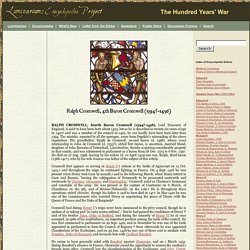
-1456), Lord Treasurer of England, is said1 to have been born about 1403, but as he is described as twenty-six years of age in 14202 and was a member of the council in 1422, he can hardly have been born later than 1394. The mistake, repeated by all the peerages, arose from Dugdale's misreading of the above inquisition. His grandfather, Ralph de Cromwell, second baron (d. 1398), whose exact relationship to John de Cromwell (d. 1355?) Robert Dudley, Earl of Leicester (c.1531-1588) ROBERT DUDLEY, EARL OF LEICESTER.

This favourite of Queen Elizabeth came of an ambitious family. They were not, indeed, such mere upstarts as their enemies loved to represent them; for Leicester's grandfather — the notorious Edmund Dudley who was one of the chief instruments of Henry VII's extortions — was descended from a younger branch of the barons of Dudley. But the love of power was a passion which seems to have increased in them with each succeeding generation, and though the grandfather was beheaded by Henry VIII for his too devoted services in the preceding reign, the father grew powerful enough in the days of Edward VI to trouble the succession to the crown.
This was that John Dudley, Duke of Northumberland, who contrived the marriage of Lady Jane Grey with his own son Guildford Dudley, and involved both her and her husband in a common ruin with himself. At an early age he had been married to Amy, daughter of Sir John Robsart. Robert Dudley, Earl of Leicester (c.1533-1588) Robert Dudley, Earl Of LeicesterBuy Print at Allposters.com.
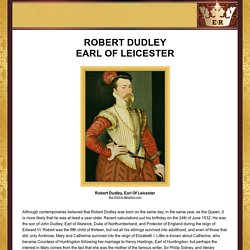
Emily's Tudor Talk: Arbella Stuart: The Prisoner Princess Part III. After the death of Edward Seymour, Arbella decided to marry his younger brother, William.

They were married and king James VI/I saw it as a political move, not a love match. He became paranoid that Arbella was trying to take his throne (which she wasn't). Arbella couldn't stay at James' court much longer, James was running the country into bankruptcy, and poor Arbella was losing money too. She decided to trip around her favourite houses and just move out of the spotlight for awhile. Sadly for Arbella she was still being thought of as an alternative to James VI/I. A group of rebels, (including Guy Fawkes) were planning on blowing James VI/I house with him in it as well as his wife and children and Arbella would take over the government.
Well, somebody eventually caught 'em and so the Gunpowder Plot ended. Eventually, James VI/I who had once welcomed Arbella, now tried to arrest her. Google Play. Robert Harley, 1st Earl of Oxford and Earl Mortimer. Harley's government agreed to the Treaty of Utrecht with France in 1713, bringing an end to twelve years of British involvement in the War of the Spanish Succession.
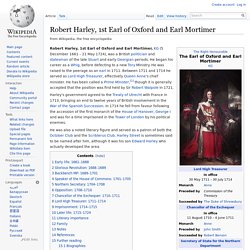
In 1714 he fell from favour following the accession of the first monarch of the House of Hanover, George I and was for a time imprisoned in the Tower of London by his political enemies. He was also a noted literary figure and served as a patron of both the October Club and the Scriblerus Club. Harley Street is sometimes said to be named after him, although it was his son Edward Harley who actually developed the area. Early life: 1661–1688[edit] Edward de Vere. What did he look like?
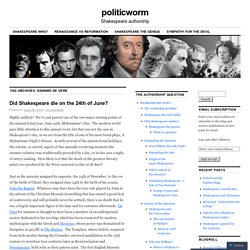
Once again, as with his education, his presence in London, and his presence at Court, nobody knows; meaning nobody in the Shakespeare Establishment, i.e. the University English Departments, writers published by university presses, speakers from the Shakespeare Birthplace Trust, and the mainstream media. None have any real answers, all are still heavily, fiercely, defensively, protective of the Stratford biography. Dozens of portraits from the period have been promoted as Shakespeare at one time or another; all have failed to convince either the reading public or the authorities. George Douglas, 13th Earl of Morton, 1662-1738.
George, born in 1662, was the 5th son of Sir James of Smithfield, 10th Earl of Morton and the 3rd of his sons to bear the Morton titles.
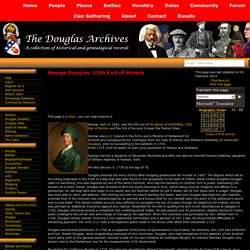
George was a Lt. Colonel in the Army and a Minister of Parliament for Kirkwall and subsequently for Linlithgow then the Isles of Orkney and Shetland (following Sir Alexander Douglas) prior to succeeding to the earldom in 1730. From 1725 until his death he was Lord Lieutenant of Orkney and Shetland. - Person Page 10296. - Person Page 10296. Devetashka - the Bulgarian Cave with 70,000 Years of Human Habitation. Devetashka cave is an enormous cave in Bulgaria, which has provided shelter for groups of humans since the late Paleolithic era, and continuously for tens of thousands of years since then.

Now abandoned by humans, it remains a site of national and international significance and is home to some 30,000 bats. Making of Europe unlocked by DNA. DNA sequenced from nearly 40 ancient skeletons has shed light on the complex prehistoric events that shaped modern European populations. A study of remains from Central Europe suggests the foundations of the modern gene pool were laid down between 4,000 and 2,000 BC - in Neolithic times. These changes were likely brought about by the rapid growth and movement of some populations.
The work by an international team is published in Nature Communications. The Scythians and their descendants. The fine-scale genetic structure of the British population : Nature. Scientists Seek Ban on Method of Editing the Human Genome. Photo A group of leading biologists on Thursday called for a worldwide moratorium on use of a new genome-editing technique that would alter human DNA in a way that can be inherited. The biologists fear that the new technique is so effective and easy to use that some physicians may push ahead before its safety can be assessed. They also want the public to understand the ethical issues surrounding the technique, which could be used to cure genetic diseases, but also to enhance qualities like beauty or intelligence. The latter is a path that many ethicists believe should never be taken. Using GEDmatch to see where you match.
I think the switch from Ancestry.com DNA test results, where your tree gets searched for you, making using DNA with genealogy easy – to GEDmatch where you have to figure out how to use the data yourself, is quite difficult. So this post is an attempt to help my cousins who have tested at ancestry and uploaded to GEDmatch. It might also help others new to GEDmatch who want to look at where they match a [possible] cousin by walking through that process. Sample from the GEDmatch one-to-one comparison First make sure that you understand current DNA basics (click here for my page on that). The image above is from a recent new match to my Dad uploaded from ancestry.com.
Looking at my spreadsheet I see about 15 other folk matching on that segment, none of whom I have found a known ancestor with, but wait! 3rd cousin Katy versus new match. Ashkenazi Amsterdam in the Eighteenth Century (by Mr. Moshe Mossel) Cahjp.huji.ac. Retracing Old Footsteps. Genie Milgrom. “Something in me has awoken. I can’t explain it but I know beyond a shadow of a doubt that I’m Jewish. There are no Jews where I live [in New Mexico]. I was raised Catholic but in Catholic school they would say I didn’t look it. My parents put a huge Star of David with our Christmas lights.
Genie Milgrom receives hundreds of emails like this one every year. Descendents of anousim are emerging in greater numbers than ever before. TTT Surname List - Google Tabellen. An outstretched arm : a history of the Jewish C... Téléchargements mobiles - Foundation for Northern European History and Polytheism. Téléchargements mobiles - Werkgroep Lokasenna. Journal of Neolithic Archaeology. Genetic Genealogy. DNA analysis is an important new scientific tool increasingly being used by genealogists as an aid to research. DNA testing is not a replacement for traditional documentary research, but can be used in conjunction with the paper records.
A DNA test can determine whether two people share a common ancestor within a certain number of generations. DNA can thereby validate (or disprove) genealogical theories about a family's lineage and ancestry. Testing can also provide information beyond the documented record trail, by connecting people having the same surname who have no proven historical link. Y-Chromosome Biallelic Haplogroups. Are the English really Germans or Spaniards? Family History - The STIRLING Surname. The Germani: Germanic Peoples Origins and History. Who were they? The Germani entered Roman consciousness as unknown enemies, suddenly looming from the misty distance. Not that the Romans had a collective ethnic name for the tribes who swooped upon them in 113 BC, driven by the flooding of their own lands to look for a new homeland. THE MONIKIE STORY, a book. Rob-roy-dna-courier-extract.gif (GIF Image, 538 × 1280 pixels) - Scaled (78%) St*rling DNA Project Has a Big Breakthrough - csowiki.
Article regarding Race & DNA - on the Monikie, Scotland Website. (W/T) Races and DNA. The Seven Daughters of Eve: The Science That Reveals Our Genetic Ancestry - Bryan Sykes. Saxons, Vikings, and Celts: The Genetic Roots of Britain and Ireland - Bryan Sykes. Welsh presenter Angharad Mair digs up her DNA roots in the Eastern Mediterranean. Veteran television presenter Angharad Mair is the first Welsh celebrity to discover the truth about her ancestral roots as part of a ground-breaking DNA survey examining the country’s genetic make-up. The Carmarthen-born star was given the results live on last night’s edition of the primetime S4C magazine show Heno, during which it was revealed her ancient forbears were more likely to have hailed from somewhere a lot more exotic than West Wales. PBS documentary traces 350 years of Jewish migration. Imperial Cult.
BBC Wales - History - Themes - The Dream of Macsen Wledig. The stone of Destiny. Kings and Queens of Scotland - Genealogical Tables - Scottish Kings. Ancestors of Caden Michael Norquist. Habsburg family tree. Habsburg family tree. Freeman Fly 'Illuminati Demonology & Genealogy' (Uncut) Prisonplanet.tv - 07-25-08. Bardic Poetry Database. EBK Dark Age Archaeology Home Page. EBK: Kingdoms of Post-Roman Britain Index. Unavailable in your country. Nennius - Arthur's Twelve Battles - the ninth at the City of the Legion, Cair Lion. Genealogy of the d'Este Princes « Facsimile edition. Psalter. - Medieval and Renaissance Manuscripts. Six Old English Chronicles: Of which Two are No...
Ohr Torah on the Parsha: The Covenant at Sinai - Judaism - Arutz Sheva. Christianization and the Rise of Christian Monarchy: Scandinavia, Central ... Rewriting the Old Testament in Anglo-Saxon Verse: Becoming the Chosen People - Samantha Zacher. Gt_wessex_2.jpg (JPEG Image, 925 × 1162 pixels) - Scaled (86%) Genealogical_Table_Normandy.jpg (JPEG Image, 659 × 572 pixels) Johnson-Wallace & Fish-Kirk Family Pedigree Charts Wigeric, Count of Bidgau. Capetian Dynasty Divine Right to Rule. English Monarchs - Kings and Queens of England - Egbert. Descendants of CLOVIS (bef. 420-448) House of Alvensleben. Ancestry of Elizabeth I of England. Aryans, Jews, Brahmins: Theorizing Authority through Myths of Identity - Dorothy M. Figueira. 1985EdwardsPhD.
Kings%20and%20Kingdoms%20of%20Early%20Anglo-Saxon%20England. Speculum - Abstract - The Concept of Royal Power in Carolingian Oaths of Fidelity. The Uses of the Past in the Early Middle Ages. Anglo-Saxon royal genealogies and Germanic oral tradition. Anglo-Saxon England - Abstract - Why is the <i>Anglo-Saxon Chronicle</i> About Kings? Anglo-Saxon England - Abstract - The Anglian collection of royal genealogies and regnal lists. Charlemagne’s DNA and Our Universal Royalty.
"Creating kings in post-conquest England: The fate of Charlemagne in An" by Wendy Marie Hoofnagle. Fatherlands: State-Building and Nationhood in Nineteenth-Century Germany - Abigail Green. The Cult of Kingship in Anglo-Saxon England: The Transition from Paganism to ... - William A. Chaney. Pdf-preview.axd (PNG Image, 980 × 1504 pixels) - Scaled (66%) Thietmar of Merseburg on Rituals of Kingship - Viator - Volume 26, Volume 26 / 1995 - Brepols Publishers.
a055364. 21429115_inha_1.pdf. a055364. Kings%20and%20Kingdoms%20of%20Early%20Anglo-Saxon%20England. Celto-Germanic Culture, Myth and History. The Barbarian Conversion: From Paganism to Christianity - Richard A. Fletcher - Google Books.